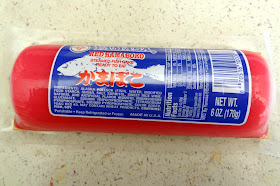 Kamaboko (蒲鉾) is a Japanese ingredient made from white fish that have been pureed, mixed with flavorings, and then steamed to form a steamed fish cake.
Kamaboko (蒲鉾) is a Japanese ingredient made from white fish that have been pureed, mixed with flavorings, and then steamed to form a steamed fish cake. Traditionally, kamaboko was formed on a wooden board for steaming which produces the hallmark half-moon shape you see it in.
Nowadays you can find kamaboko without the wood, but most varieties will still be steamed on wood.
 |
| Imitation crab sticks work great for cheap sushi |
Does this sound totally weird? I wish I could have described it more appetizingly. However, the pureed white fish, called surimi, is the same process that is used to make imitation crab (called kanikama, which is short for kani-kamaboko). So if you've enjoyed a california roll, you've had surimi. The biggest difference between imitation crab and kamaboko is just the texture as kamaboko is chewier and firmer.
 |
| Kamaboko and narutomaki with awesome designs! |
You will also see narutomaki, a type of kamaboko that has has a fun swirl in the middle and is round rather than half moon. They taste exactly the same.
There are some other surimi products that I've used on this blog that slightly different in taste, however.
 |
| Chikuwa (L) and Satsuma Age (R) |
Satsuma-age (薩摩揚げ) is another type of surimi product where the fish cake is deep fried. Sometimes you will find the fish paste is first mixed with other ingredients like onions, ginger, or even other meats such as shrimp.
Last but not least, hanpen (半片)is made with surimi that has been boiled, which yields a softer and more delicately flavored fish cake.
Dishes that use Kamaboko or Narutomaki:
Itawasa
Kamaboko Dip
Oden
Toshikoshi Soba
Yawatahama Champon
Dishes that use Chikuwa:
Oden
Chikuwa Teriyaki Donburi
Dishes that use Satsuma-age:
Oden
Chikuwa Teriyaki Donburi
Dishes that use Kanikama:
Ehomaki

No comments:
Post a Comment